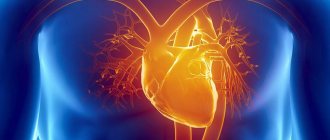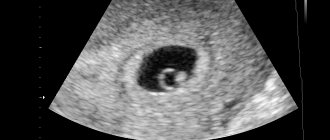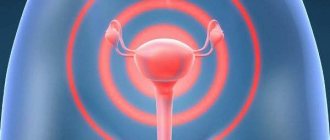Perinatal damage to the central nervous system in newborns begins to develop while still in the womb. The diagnosis of PPCNSL is a pathology that involves disruption of the fetal brain activity. PPCNS manifests itself in newborns in the form of mental, speech and motor disorders.
The perinatal period is divided into three main stages:
- antenatal - from four months until the moment of birth;
- intrapartum - the immediate process of childbirth;
- neonatal - a time interval covering the first week of a newborn’s life.
It is worth noting that today medicine is quite well developed, so the disease is not diagnosed in children older than one month. After the first month of life, the doctor must make an accurate diagnosis, since this is the time that shows how badly the child’s central nervous system has been damaged. Based on the examination results, the doctor prescribes an appropriate therapeutic course.
Causes and risk factors
The reasons why perinatal damage to the central nervous system may develop are quite varied, among the most popular:
- somatic disease of the mother, which is accompanied by chronic intoxication;
- the presence of acute infectious diseases or chronic foci of infection while the expectant mother was carrying the child;
- if a woman’s nutritional process is disrupted, or she is not ripe for pregnancy and childbirth;
- changes in metabolism or the presence of a hereditary factor also entail a disorder of the nervous system in the unborn child;
- in case of severe toxicosis, both at an early stage and at a late stage, or the appearance of other problems with bearing a child;
- the environment is an important factor in the development of the disease;
- the appearance of pathology during childbirth - this may be weak labor, accelerated labor;
- if a child is born premature, then his body is not fully developed, therefore, against this background, a disturbance in the functioning of the central nervous system may appear;
- Children who have a hereditary factor are at greatest risk of developing central nervous system lesions.
All other causes of PPCNS are situational and, to a greater extent, their occurrence is simply impossible to predict.
Perinatal damage to the central nervous system (or hypoxic encephalopathy) is a combination of various changes and disturbances in the functioning of the nervous system caused by many factors. The term "perinatal" refers to the period from 28 weeks of pregnancy to several weeks after birth - changes in the nervous system develop over a period of time.
Then the neurologist must establish the exact cause of the pathology, the nature and degree of changes in the nervous system, predict the further development of the disease, develop tactics and prescribe treatment.
The causes of perinatal lesions depend both on the pathologies and lifestyle of the mother, and on the effects of toxic factors during pregnancy and childbirth:
- infectious diseases of the mother during pregnancy;
- chronic diseases of the pregnant woman, accompanied by intoxication;
- metabolic disorders and hereditary diseases in the mother;
- early pregnancy, lack of vitamins and other substances;
- severe pregnancy (early and late toxicosis, threat of miscarriage);
- fetal prematurity at birth;
- complications of the labor period (rapid labor, long anhydrous period, entanglement of the umbilical cord);
- harmful effects of external factors (ecology, toxic emissions).
The perinatal period is a concept that combines several time intervals in the development of a child. In each of these intervals, certain factors have the greatest influence:
- Antenatal (from 28 weeks before birth) the fetus is influenced by intrauterine infections - IUI (toxoplasmosis, cytomegalovirus infection, hepatitis, etc.), exacerbations of chronic diseases of the mother, toxic factors (alcohol, smoking, drugs), the influence of various types of radiation. During this period, intensive maturation of the nervous system occurs, and unfavorable factors can lead to the birth of a premature baby.
- Intrapartum period (childbirth) - a long anhydrous interval, weak labor, rapid labor, manual obstetrics, cesarean section, entanglement of the fetus with the umbilical cord (hypoxia).
- Postnatal period (immediately after birth) - trauma and neuroinfections.
Damage to the central nervous system can be caused not only by one reason, but also by a combination of factors. The more factors are involved in the development of the disease, the more severe it is.
What is perinatal CNS damage?
The perinatal period begins from the 22nd week of pregnancy and lasts until the 7th day of the baby’s life, including the birth process itself.
Perinatal damage to the central nervous system in newborns is one of the most common diagnoses. And parents often panic. But in many cases, such a diagnosis is routine, that is, a neurologist can make it even if only one reflex is impaired. The process of childbirth is very traumatic for the baby, since when passing through the birth canal it is almost impossible to avoid injury. Therefore, in our time, more than 90% of children make such an entry on their cards.
Symptoms and diagnostic criteria
PPCNSL is conventionally divided into several periods, depending on at what stage the disorder was identified and how it manifested itself.
The acute period lasts from 7 to 10 days, extremely rarely, but it can last up to a month. The period during which recovery occurs can last up to six months. If the child’s body recovers slowly, this period may take up to 2 years.
Pediatric neurologists distinguish the following types of perinatal lesions of the central nervous system, depending on the accompanying symptoms and syndrome:
- Violation of muscle tone, which is accompanied by a complex of disorders associated with breathing. This syndrome is diagnosed according to abnormalities depending on the age of the newborn. In the initial period of a child’s life, it is quite difficult to diagnose this syndrome, since in addition to this, physiological hypertonicity occurs.
- Syndrome associated with sleep disturbances and chin twitching. This syndrome can be diagnosed only when flatulence is excluded.
- Depression of the nervous system. This syndrome is diagnosed in children who are not active in the first months of their lives, they sleep a lot, and have decreased tone.
- An unfavorable prognosis for a child if intracranial hypertension syndrome develops. Its main signs are increased excitability and nervousness, and the fontanel begins to swell.
- One of the most dangerous and severe syndromes in PPCNSL is convulsive, which is one of the most serious manifestations of perinatal damage to the central nervous system. In addition, any attentive mother can notice deviations in her child’s health much faster than a neurologist, if only because she monitors him around the clock and more than one day.
In any case, a baby living for the first year with any (even minimal, but not passing) deviations in health requires repeated consultations with specialists (if necessary, additional examination), careful observation and therapeutic measures if necessary.
Not every mother who does not have a medical education will be able to distinguish and determine at first glance that her child has a perinatal lesion of the central nervous system.
But, neurologists accurately determine the disease by the appearance of symptoms that are not characteristic of other disorders that are characteristic of the youngest patients.
Symptoms of PCNSL:
- When examining the baby, muscle hypertonicity or hypotonicity may be detected;
- the child is excessively restless, anxious and excited;
- the occurrence of shaking in the chin and limbs (tremor);
- the appearance of seizures;
- when examined with a hammer, there is a noticeable loss of sensitivity;
- the appearance of unstable stools;
- heart rate changes;
- the appearance of irregularities on the child’s skin.
As a rule, after a year these symptoms disappear, but then appear with renewed vigor, so this situation simply cannot be neglected.
One of the most dangerous manifestations and consequences of PPCNSL in the absence of a response to symptoms is the suspension of the development of the child’s psyche. The speech apparatus does not develop, and there is a delay in the development of motor skills. Also, one of the manifestations of the disease may be cerebrasthenic syndrome.
There are several ways of development of perinatal damage to the central nervous system in newborns, depending on the cause and subsequent symptoms, the analysis of which allows us to make an initial diagnosis:
- If a lack of oxygen is clearly detected while the baby is inside the mother’s body (hypoxia), then hypoxic ischemic damage to the central nervous system is diagnosed.
- During childbirth, the baby's tissue structure may be damaged (this can be either the brain or the spinal cord). In this case, we are already talking about a traumatic lesion of the central nervous system, resulting in changes in the functioning of the brain.
- In case of metabolic disorders, metabolic and toxic-metabolic lesions may appear. This may be due to the use of alcohol, medications, drugs, or nicotine during pregnancy.
- Changes in the central nervous system in the presence of infectious diseases of the perinatal period.
Perinatal damage to the central nervous system is based on pathological factors that occur immediately before, during or immediately after childbirth. Factors in the development of PPCNSL can be divided into 3 groups:
- hypoxic (lack of oxygen) damage to the fetal brain in the antenatal period (intrauterine hypoxia), during childbirth (acute labor hypoxia) and immediately after childbirth leads to the ischemic genesis of the disease;
- traumatic lesions of the fetal head during the birth period;
- mixed (hypoxic-traumatic) factors.
Each group includes many causes of changes in the nervous system. The polyetiology of the disease creates difficulties in its diagnosis and treatment.
The most common factors in the development of CNS pathology are hypoxic-ischemic, causing clear clinical manifestations. There are several degrees of such lesions:
- Stage I - the newborn’s condition is stable, Apgar score 6-7, slight cyanosis, decreased muscle tone and reflexes, sleep disturbance, increased excitability, frequent regurgitation.
- II degree - severe ischemic damage, suppression of reflexes, including sucking, hypertonicity, autonomic disorders (changes in heart rate, impaired respiratory movements), intracranial hypertension syndrome.
- III degree - deep hypoxic damage, impaired cardiac activity, lack of breathing, after birth cardiopulmonary resuscitation is carried out, sharp depression of brain function, atony, areflexia. The prognosis is unfavorable.
There are several periods of development of the disease:
- acute - from 7 days to 1 month - severe symptoms, hospital treatment required;
- restorative - up to 6-24 months - improvement of general condition, the main focus is on restorative procedures (massage, exercise therapy, physiotherapy).
The clinical picture of perinatal lesions may vary. A neurologist makes a diagnosis of perinatal damage to the nervous system, taking into account the present symptoms, only after a complete examination of the patient.
Signs of the disease:
- disorder of muscle tone - hypotonicity (meaning muscle flaccidity in a newborn) or hypertonicity (bent arms and legs), breathing problems, at an early age - physiological increased tone, which is difficult to distinguish from manifestations of the disease;
- chin twitching and sleep disturbances;
- signs of depression of the nervous system - the child is lethargic, sleeps a lot, is inactive;
- hypertensive syndrome (increased intracranial pressure) - headaches, anxiety, mild irritability, bulging fontanel;
- convulsive syndrome - convulsions of varying localization and severity;
- change in heart rhythm;
- dyspepsia in the form of unstable stools.
How it manifests and develops
During the course of the disease, three periods are distinguished: acute (from the prenatal period until the first month after birth), recovery (from the second month to one year, and in premature babies up to two years) and outcome of the disease. Each period has its own specific symptoms.
In the acute period, the baby may experience:
- Hydrocephalus (hydrosis of the brain), due to which the baby’s head becomes enlarged, and the fontanel pulsates and protrudes above the surface of the skull;
- Convulsions of both limbs and the whole body.
- Vegetative-visceral syndrome due to impaired vascular tone;
- Inhibition of the nervous processes of the central nervous system, due to which basic reflexes and motor activity are significantly reduced;
- Muscular dystonia can be either depression or stimulation of the central nervous system (the baby often cries for no reason, his chin trembles nervously, sleep is intermittent and inconsistent). This condition is observed with a mild degree of the disease;
- Comatose state, when the baby falls into a coma. The most severe form of the disease. The activity of the central nervous system is extremely depressed. The child is in intensive care.
In the recovery period, at the very beginning, with moderate and severe forms of the disease, it seems as if the baby is getting better, his reflex excitability is restored, and the manifestations of PCNSL are not so obvious.
But things get worse very quickly.
The child has delays in psycho-speech development, which is natural with such a disease. He later masters various motor skills, such as holding the head, crawling, sitting, walking. He also begins to speak later than his peers. The outcome of the disease becomes clear by the time the child turns one year old.
Find out how and from what age you can use baby formula: “Agusha 1”, “Hipp Combiotic 1”, “Humana Expert 1”, “Baby Premium 1”, “Nutrilak 1”, “NAS Optipro”, “Nutrilon Premium”, “ Frisolak 1", "Malyutka 1", "Similak Premium 1", "Similak 1".
Even if the treatment is successful, the baby may have developmental delays, hyperactivity and cerebroasthenic syndrome, due to which the baby becomes weather dependent, hysterical, gets tired quickly, sleeps poorly and is often anxious.
Did you know? From the moment of birth, a baby's brain grows three times larger every year compared to the previous year. But in old age the picture is the opposite: every year the weight of the brain decreases by one gram.
Periods of disease development
There are four phases of development of the pathological process with lesions of the nervous system in children during the first year of life.
The first phase is an acute period of the disease, lasting up to 1 month of life, directly related to hypoxia and circulatory disorders, which can clinically manifest itself in the form of depression syndrome or central nervous system excitation syndrome.
The second phase of the pathological process extends to the 2-3rd months of life, the severity of neurological disorders decreases: the general condition improves, motor activity increases, muscle tone and reflexes normalize. Electroencephalographic indicators improve.
This is explained by the fact that the damaged brain does not lose its ability to recover, but the duration of the second phase is short and soon (by the 3rd month of life) an increase in spastic phenomena may occur. The phase of “unjustified hopes for a complete recovery” is ending (it can be called the phase of false normalization).
The third phase - the phase of spastic phenomena (3-6 months of life) is characterized by the predominance of muscle hypertension (i.e., increased muscle tone). The child throws back his head, bends his arms at the elbows and brings them to his chest, crosses his legs and puts them on his toes when leaning, tremor is pronounced, convulsive states are not uncommon, etc.
A change in the clinical manifestations of the disease may be due to the fact that during this period there is a process of degeneration (the number of dystopically altered neurons increases). At the same time, in many children with hypoxic damage to the nervous system, the outlined progress in the second phase of the disease is consolidated, which is detected in the form of a decrease in neurological disorders.
The fourth phase (7-9 months of life) is characterized by the division of children with perinatal damage to the nervous system into two groups: children with obvious psychoneurological disorders up to severe forms of cerebral palsy (20%) and children with normalization of previously observed changes in the nervous system (80 %). This phase can conventionally be called the phase of completion of the disease.
Depending on the duration of the pathological process, the symptoms of the disease change. Each period is characterized by its own manifestations:
- acute – weakness, lethargy, physical inactivity, muscle hypotonicity, hyperexcitability, hypertonicity, sleep disturbances, the baby’s limbs are bent and do not straighten on their own, the chin is shaking;
- in the early period of recovery, the symptoms are smoothed out, but focal neurological manifestations (paresis, paralysis) may occur, hydrocephalic syndrome develops (the fontanelle bulges, the subcutaneous venous network on the head is expanded), changes in thermoregulation, pronounced dysfunctions of the digestive organs, and a syndrome of motor disorders are observed;
- late recovery – restoration of muscle tone (complete normalization of tone depends on the depth of damage to the nervous system);
- residual manifestations are mental and neurological disorders.
Forecast
Even if the baby was treated correctly and on time, perinatal damage to the central nervous system will leave its marks forever. With a mild degree of the disease, such consequences will be some delay in development and impulsiveness of the baby on the one hand, as well as lethargy, apathy, anxiety and sleep disorders on the other.
A severe form of PPCNSL in newborns has the same consequences: the child may develop hydrocephalus (hydropy) of the brain, cerebral palsy and epilepsy.
In general, approximately 30% of children recover completely, 40% of children have impairments in the functionality of the nervous system, and another 30% have organic impairments. Sometimes death occurs.
Important! To prevent the onset of such a serious disease, a pregnant woman must undergo all routine examinations, avoid stress, infections, and eliminate bad habits from her life.
Diagnostics
According to experimental studies, the brain of a newborn child is able to form new neurons in response to damage. Early diagnosis and timely treatment are the key to restoring the functions of affected organs and systems, since pathological changes in young children are more amenable to reverse development and correction; anatomical and functional restoration occurs more completely than with advanced changes with irreversible structural changes.
Restoration of central nervous system functions depends on the severity of the primary injury. In the laboratory of clinical biochemistry of the Scientific Center for Children's Health of the Russian Academy of Medical Sciences, studies were carried out that showed: for laboratory diagnosis of the severity of perinatal lesions of the nervous system in children, it is possible to determine in the blood serum the content of special substances - “markers of damage to nervous tissue” - neuron-specific enolase (NSE), which contains mainly in neurons and neuroendocrine cells, and myelin basic protein, which is part of the membrane surrounding the processes of neurons.
The increase in their concentration in the blood of newborns with severe perinatal lesions of the nervous system is explained by the entry of these substances into the bloodstream as a result of destruction processes in brain cells. Therefore, on the one hand, the appearance of NSE in the blood allows us to confirm the diagnosis of “perinatal damage to the central nervous system”, and on the other hand, to establish the severity of this lesion: the higher the concentration of NSE and myelin basic protein in the baby’s blood, the more severe the damage we are talking about.
In addition, the brain of each child has its own, genetically determined (only characteristic of it) structural, functional, metabolic and other features. Thus, taking into account the severity of the lesion and the individual characteristics of each sick child plays a vital role in the processes of restoration of the central nervous system and the development of an individual rehabilitation program.
As mentioned above, methods of rehabilitation of children with perinatal lesions of the central nervous system will be covered in the next issue of the journal.
Olga Goncharova, senior researcher at the department for premature babies of the Scientific Center for Children's Health of the Russian Academy of Medical Sciences, Ph.D.
Causes of respiratory distress syndrome (RDS) in newborns
Hypercapnia. hypoxemia and acidosis increase PVR, right-to-left shunting through the foramen ovale and AP often occur, and pulmonary hypertension is a characteristic complication of severe RDS. Pulmonary blood flow is reduced, and ischemia of type II alveolocytes and pulmonary vessels appears, leading to the effusion of serum proteins into the alveolar space. The opposite situation is possible - the development of a left-to-right shunt through the ALI, which in extremely severe cases can lead to pulmonary hemorrhage.
Full-term and almost full-term babies also sometimes get RDS, but much less often than premature babies. These are mainly newborns after cesarean section or rapid labor, who have suffered asphyxia, and from mothers with diabetes. The relatively stable chest and strong respiratory drive generate very high transpulmonary pressure in full-term infants, which contributes to the development of pneumothorax.
Treatment of newborns
The sooner a diagnosis is made and treatment is started, the greater the chance of a full recovery for the child. The general course of therapy includes: drug therapy, physiotherapy, massage, physical therapy. In each period of the disease, an individual scheme of rehabilitation measures is prescribed, which depends on the patient’s age, the severity of the lesion and the duration of the disease.
Treatment of the acute stage should be carried out in a hospital setting. Newborn babies with PPCNS are hospitalized after the maternity hospital in specialized medical institutions. Treatment is aimed at eliminating the prevailing syndrome.
Treatment and rehabilitation measures
If PPCNS is detected immediately after birth, then the baby’s rehabilitation is carried out immediately. In the acute period, doctors relieve cerebral edema, eliminate and prevent seizures.
With the help of special vitamins, they reduce the permeability of vascular walls, give medications to improve myocardial contractions, even out the metabolism of nerve tissue and create a gentle lifestyle for the baby.
During the recovery period, treatment depends on the symptoms of PPCNS that appear in newborns.
In general, the child is given stimulating therapy, which provokes the growth of brain capillaries, improves nutrition and restoration of damaged areas.
Danger and consequences
There is an opinion among experts that if the central nervous system of the fetus has been damaged, it cannot be completely restored. But practicing neurologists say the opposite. They say that if the disease is treated correctly, it is possible to achieve partial or complete restoration of the functions of the nervous system.
But even despite such an optimistic forecast, if you look at all diseases associated with the nervous system, then 50% of their total number leads to disability, while about 80% of it is allocated to perinatal damage to the central nervous system.
Appendix B: Patient Information
Consequences of perinatal damage to the central nervous system with muscle hypotonicity - a disease that is the outcome of perinatal damage to the central nervous system of hypoxic-ischemic origin (Cerebral ischemia P91.0, Intracranial non-traumatic hemorrhage in the fetus and newborn II, III degrees P52, Periventricular cysts (acquired) in a newborn P91 .
In premature babies born with ELBW, VLBW, during the first 6 months of life, often o. For children born full-term, prematurely with low body weight, the gradual development of persistent motor disorders is characteristic. Neurological symptoms appear as the child's nervous system matures.
Apoptosis (delayed programmed death of neurons) can be reversible, so the doctor has time to prevent neuron death - the so-called “therapeutic window”.
The prognosis depends on the severity of the damage to the central nervous system and the effectiveness of the treatment.
Conducting early, staged restorative treatment/rehabilitation determines a more favorable prognosis and improves the quality of life of children, in some cases preventing their disability.
Is there prevention?
Perinatal damage to the central nervous system is a polyetiological disease, and there are no general recommendations for prevention. Preventive measures should be aimed at eliminating each cause separately.
Particular attention should be paid to the health of the expectant mother. Women must register for pregnancy at the antenatal clinic on time and undergo all necessary examinations. Only a complete picture of the health status of the expectant mother will enable the gynecologist to properly plan the pregnancy. If necessary, additional tests and treatment should be performed.
In emergency situations in a hospital setting, the mother and newborn are provided with qualified medical care. The neonatologist assesses the baby’s condition and, if necessary, prescribes therapy.
During the postnatal period, it is necessary to carefully monitor the baby’s condition, regularly visit the pediatrician, and carry out all necessary appointments. Consultation with specialists is required to identify early signs of pathology. Even healthy children undergo preventive courses of massage, exercise therapy and physiotherapeutic procedures.
Perinatal damage to the central nervous system is not a death sentence. With a timely, accurate diagnosis and effective treatment, care and control by parents, complete restoration of the functions of the nervous system is possible. In case of severe perinatal damage, a good result can be achieved and the consequences can be minimized. If this pathology is ignored, the risks of developing severe irreversible consequences are high.
The second horror story. Muscular dystonia syndrome
Having heard about hypo- or hypertonicity, experienced parents often brush it off: it’s a common thing, they say. Indeed, many have encountered this scourge, but for young mothers and fathers, a doctor’s message about muscular dystonia can seriously frighten them.
In fact, it is quite possible to combat “stiffness” (with hypertonicity) or lethargy (with hypotonicity) of movements. And you don’t need to do anything too complicated. Daily gymnastics, which any mother can easily master, and 2–3 courses of massage can help most babies with muscular dystonia. In many cases, water procedures, which can be done at home, in a regular bath, significantly improve the child’s condition. Drug therapy is prescribed extremely rarely, only when gymnastics and massage do not work or do not help completely.
Complex of therapeutic measures
If a child develops an acute period of illness, he is first sent to the intensive care ward. Diuretics are used in case of suspected cerebral edema - dehydration therapy can be carried out.
Depending on what symptoms the baby has, with the right treatment, you can get rid of seizures, disorders of the respiratory tract and cardiovascular system, and muscle disorders.
If the disease is complicated, the child is fed through a tube. To restore the basic functions of the central nervous system, as well as to reduce the manifestation of neurological symptoms, the baby is prescribed a whole range of drugs:
- to relieve seizures, a course of taking Radodorm, Finlepsin, Phenobarbital may be prescribed;
- if the child periodically regurgitates, Motilium or Cerucal is prescribed;
- if there are disorders of the musculoskeletal system, Galantamine, Dibazol, Alizin, Proserin are prescribed;
- In order to reduce possible hemorrhages, it is recommended to use the drug Lidaza.
Nootropic drugs can also be used in treatment, which can restore trophic processes in the brain - Piracetam, Cerebrolysin, glutamic acid.
In order to stimulate general reactivity, a newborn baby is given a course of therapeutic massage and special gymnastics.
If parents detect at least one of the signs of central nervous system damage, they should immediately consult a doctor. Do not forget that the development of each child is an individual process.
Such individual characteristics of each newborn child in each specific case play an important role in the process of restoring the functions of higher nervous activity.
Classification and types of syndromes
There are three main periods during PPCNS:
- Acute (first 4 weeks of life).
- Recovery: early (8-15 weeks); late (from 16 weeks to 12 months in children born at term, up to 24 in premature infants).
- Outcome: complete disappearance of all disorders; persistence of some manifestations: developmental delay, hyperactivity syndrome; severe consequences: epilepsy, cerebral palsy, hydrocephalus.
Each period has its own manifestations and symptoms, which doctors, for convenience, identify in the form of so-called syndromes. In approximately half of the cases, one small patient may experience several syndromes at once.
At the first stage, the following signs are most often identified:
- increased nervous excitability (increased or decreased tone, shuddering, tremors, anxious sleep, frequent crying);
- vegetative-visceral (cardiovascular rhythm disturbance, unstable stool, marbling of the skin, strong gases, regurgitation);
- convulsive (periodic twitching of the arms, legs, head in the form of attacks, frequent shudders);
- hypertensive-hydrocephalic (increased intracranial pressure, swelling of the fontanelle, anxiety, accelerated head growth).
The recovery period has similar syndromes, plus the following points are added to them:
- delayed PMR;
- motor disorders.
If a child does not smile, does not babble, or does not show any interest in toys or the outside world, you need to sound the alarm before it is too late.
Preventive actions
In order for the baby to be healthy, it is necessary:
- completely give up alcohol, drugs, smoking;
- avoid infectious diseases during pregnancy;
- if indicated, carry out heat treatment, which improves blood flow and warms the tissues;
- As soon as the baby is born, you can attend an underwater shower-massage course, which is carried out in warm water and has a beneficial effect on the development of the baby’s muscle tone; if this is not possible, you can perform a manual massage under water.
Features of the diagnosis of PPCNSL
After birth, children are required to be examined by a neonatologist, assessing the degree of hypoxia. It is he who can suspect perinatal damage based on changes in the condition of the newborn. The conclusion about the presence of pathology is confirmed or refuted in the first 1-2 months. During this entire time, the baby is under the supervision of doctors, namely a neurologist, pediatrician and an additional specialist with a narrow focus (if required). Deviations in the functioning of the nervous system require special attention in order to be able to correct them in time.
INTERESTING: What does an Apgar score of 8/8 mean?
| PPCNS form | Characteristic symptoms |
| Lightweight |
|
| Average |
|
| Heavy |
|
Reasons for development
Very often, the cause of the development of PPCNSL is fetal hypoxia during the intrauterine period.
Among the reasons leading to perinatal damage to the central nervous system in an infant, it is worth noting four main ones:
- Fetal hypoxia during the intrauterine period. This deviation is due to a lack of oxygen entering the baby’s blood from the mother’s body. Provoking factors are harmful working conditions of the pregnant woman, bad habits such as smoking, past infectious diseases and previous abortions.
- Injuries caused during childbirth. If a woman has weak labor, or the baby is delayed in the pelvis.
- Violation of metabolic processes. They can be caused by toxic components that enter the pregnant woman’s body along with cigarettes, alcoholic beverages, narcotic substances and potent medications.
- Viral and bacterial infections that enter the mother's body during pregnancy, abbreviated as IUI - intrauterine infections.
Consequences of the disease
In most cases, by the time the child is one year old, almost all the symptoms accompanying damage to the nervous system have passed. Unfortunately, this does not mean at all that the disease has receded. Usually after such an illness there are always complications and unpleasant consequences.
After undergoing PCNSL, parents may experience child hyperactivity
Among them are:
- Hyperactivity. This syndrome is characterized by aggressiveness, tantrums, learning difficulties and memory problems.
- Developmental delay. This applies to both physical and speech and mental development.
- Cerebroasthenic syndrome. It is characterized by the child's dependence on weather conditions, mood swings, and restless sleep.









